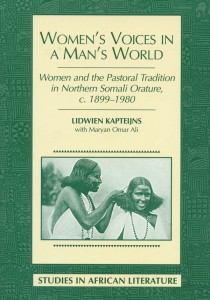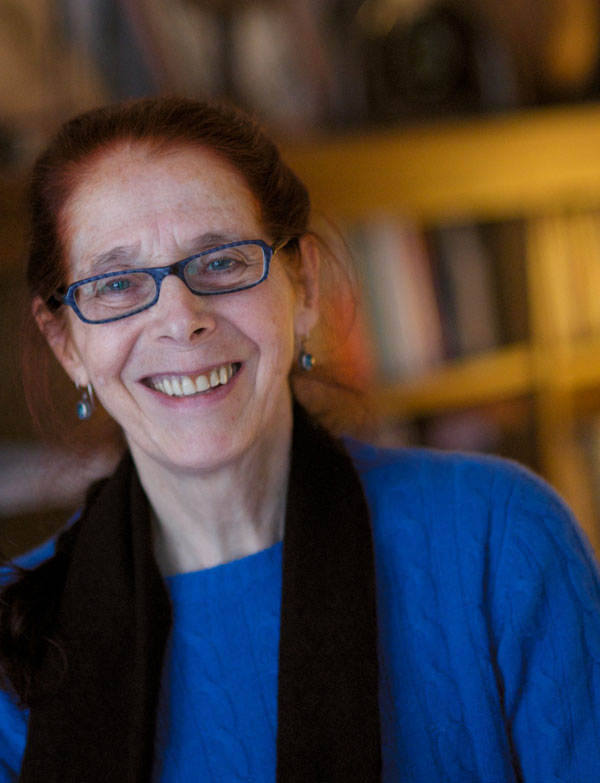Blog March 17, 2014
Love Songs in Somalia: Music of a Lost World
A couple of years ago, I received an email message from Lidwien Kapteijns (LID-win KAP-tains, like “captain”), a professor of history at Wellesley College. She told me she was a co-trustee of probably the largest existing collection of Somali popular songs from the ‘60s, ‘70s and ‘80s, and that she thought they would make the basis for a terrific Afropop program. This collection of some 2000 songs was originally compiled, in cassette form, by the late Maryan Omar Ali, Kapteijns’s friend and, later, collaborator on the 1999 book Women’s Voices in a Man’s World. Ali brought these recordings out of Somalia in a large metal trunk that the two women came to refer to as “the love boat,” because it was essentially filled with love songs.
 I went to my own enormous African music collection and discovered that—apart from music by K’Naan, the superb, Somali-born singer and rapper—I had exactly three CDs of Somali music, almost nothing. Naturally, I was intrigued, and began a correspondence with Professor Kapteijns. Later this month, Afropop Worldwide will air the resulting program, “Reconstructing Somalia: Love Songs at the Birth of a Nation.”
This program tells a remarkable story, using the music in Maryan Omar Ali’s collection, the insights of Professor Kapteijns and the other trustee of the “love boat” Ahmed Ismael Samatar, professor of International Studies at Macalister College in Minnesota, also two Somali expatriate women in Canada, who vividly recall the heyday of this all-but-lost music from their youth in Somalia. Together, these voices bring to life a world radically different from the destruction, radicalism and clan-based violence we associate with Somalia today. The story extends right up to the present, and K’Naan, whose aunt, the late Magool, was one of the important singers of this long-gone era.
It turns out that in the early days of Somali independence after 1960, there was a lively nationwide debate about how to create a modern country that would honor and incorporate traditions, but also participate in the ways of the larger world. Poetry, theatrical plays and songs derived from those poetry and plays were absolutely central in this debate. This was a time of romance, hope, imagination and creativity, much of which has been erased from the public record by the tragic events of the past quarter-century in Somalia.
But, it turns out, the memory of this time lives on in the hearts and minds of Somalis worldwide, largely through private music collections like Ali’s, private performances by the now widely dispersed surviving artists who participated in this unique phase of history, and crucially, the internet. There are an estimated 700 Somali websites, most of them including music sections.
For non-Somali speakers, probably the best web source on all this is the YouTube channel Kapteijns has created, and is continuing to develop, as a permanent, virtual home for Maryan Omar Ali’s “love boat” collection. The channel is called HiddoSongs. Go and listen. The recordings are far from pristine, but the music is gorgeous.
Watch afropop.org for much more on this story, and listen for the complete radio program, a landmark Hip Deep edition of Afropop Worldwide.
[caption id="attachment_17315" align="aligncenter" width="583"]
I went to my own enormous African music collection and discovered that—apart from music by K’Naan, the superb, Somali-born singer and rapper—I had exactly three CDs of Somali music, almost nothing. Naturally, I was intrigued, and began a correspondence with Professor Kapteijns. Later this month, Afropop Worldwide will air the resulting program, “Reconstructing Somalia: Love Songs at the Birth of a Nation.”
This program tells a remarkable story, using the music in Maryan Omar Ali’s collection, the insights of Professor Kapteijns and the other trustee of the “love boat” Ahmed Ismael Samatar, professor of International Studies at Macalister College in Minnesota, also two Somali expatriate women in Canada, who vividly recall the heyday of this all-but-lost music from their youth in Somalia. Together, these voices bring to life a world radically different from the destruction, radicalism and clan-based violence we associate with Somalia today. The story extends right up to the present, and K’Naan, whose aunt, the late Magool, was one of the important singers of this long-gone era.
It turns out that in the early days of Somali independence after 1960, there was a lively nationwide debate about how to create a modern country that would honor and incorporate traditions, but also participate in the ways of the larger world. Poetry, theatrical plays and songs derived from those poetry and plays were absolutely central in this debate. This was a time of romance, hope, imagination and creativity, much of which has been erased from the public record by the tragic events of the past quarter-century in Somalia.
But, it turns out, the memory of this time lives on in the hearts and minds of Somalis worldwide, largely through private music collections like Ali’s, private performances by the now widely dispersed surviving artists who participated in this unique phase of history, and crucially, the internet. There are an estimated 700 Somali websites, most of them including music sections.
For non-Somali speakers, probably the best web source on all this is the YouTube channel Kapteijns has created, and is continuing to develop, as a permanent, virtual home for Maryan Omar Ali’s “love boat” collection. The channel is called HiddoSongs. Go and listen. The recordings are far from pristine, but the music is gorgeous.
Watch afropop.org for much more on this story, and listen for the complete radio program, a landmark Hip Deep edition of Afropop Worldwide.
[caption id="attachment_17315" align="aligncenter" width="583"] Lidwien Kapteijns (Eyre, 2014)[/caption]
Lidwien Kapteijns (Eyre, 2014)[/caption]
 I went to my own enormous African music collection and discovered that—apart from music by K’Naan, the superb, Somali-born singer and rapper—I had exactly three CDs of Somali music, almost nothing. Naturally, I was intrigued, and began a correspondence with Professor Kapteijns. Later this month, Afropop Worldwide will air the resulting program, “Reconstructing Somalia: Love Songs at the Birth of a Nation.”
This program tells a remarkable story, using the music in Maryan Omar Ali’s collection, the insights of Professor Kapteijns and the other trustee of the “love boat” Ahmed Ismael Samatar, professor of International Studies at Macalister College in Minnesota, also two Somali expatriate women in Canada, who vividly recall the heyday of this all-but-lost music from their youth in Somalia. Together, these voices bring to life a world radically different from the destruction, radicalism and clan-based violence we associate with Somalia today. The story extends right up to the present, and K’Naan, whose aunt, the late Magool, was one of the important singers of this long-gone era.
It turns out that in the early days of Somali independence after 1960, there was a lively nationwide debate about how to create a modern country that would honor and incorporate traditions, but also participate in the ways of the larger world. Poetry, theatrical plays and songs derived from those poetry and plays were absolutely central in this debate. This was a time of romance, hope, imagination and creativity, much of which has been erased from the public record by the tragic events of the past quarter-century in Somalia.
But, it turns out, the memory of this time lives on in the hearts and minds of Somalis worldwide, largely through private music collections like Ali’s, private performances by the now widely dispersed surviving artists who participated in this unique phase of history, and crucially, the internet. There are an estimated 700 Somali websites, most of them including music sections.
For non-Somali speakers, probably the best web source on all this is the YouTube channel Kapteijns has created, and is continuing to develop, as a permanent, virtual home for Maryan Omar Ali’s “love boat” collection. The channel is called HiddoSongs. Go and listen. The recordings are far from pristine, but the music is gorgeous.
Watch afropop.org for much more on this story, and listen for the complete radio program, a landmark Hip Deep edition of Afropop Worldwide.
[caption id="attachment_17315" align="aligncenter" width="583"]
I went to my own enormous African music collection and discovered that—apart from music by K’Naan, the superb, Somali-born singer and rapper—I had exactly three CDs of Somali music, almost nothing. Naturally, I was intrigued, and began a correspondence with Professor Kapteijns. Later this month, Afropop Worldwide will air the resulting program, “Reconstructing Somalia: Love Songs at the Birth of a Nation.”
This program tells a remarkable story, using the music in Maryan Omar Ali’s collection, the insights of Professor Kapteijns and the other trustee of the “love boat” Ahmed Ismael Samatar, professor of International Studies at Macalister College in Minnesota, also two Somali expatriate women in Canada, who vividly recall the heyday of this all-but-lost music from their youth in Somalia. Together, these voices bring to life a world radically different from the destruction, radicalism and clan-based violence we associate with Somalia today. The story extends right up to the present, and K’Naan, whose aunt, the late Magool, was one of the important singers of this long-gone era.
It turns out that in the early days of Somali independence after 1960, there was a lively nationwide debate about how to create a modern country that would honor and incorporate traditions, but also participate in the ways of the larger world. Poetry, theatrical plays and songs derived from those poetry and plays were absolutely central in this debate. This was a time of romance, hope, imagination and creativity, much of which has been erased from the public record by the tragic events of the past quarter-century in Somalia.
But, it turns out, the memory of this time lives on in the hearts and minds of Somalis worldwide, largely through private music collections like Ali’s, private performances by the now widely dispersed surviving artists who participated in this unique phase of history, and crucially, the internet. There are an estimated 700 Somali websites, most of them including music sections.
For non-Somali speakers, probably the best web source on all this is the YouTube channel Kapteijns has created, and is continuing to develop, as a permanent, virtual home for Maryan Omar Ali’s “love boat” collection. The channel is called HiddoSongs. Go and listen. The recordings are far from pristine, but the music is gorgeous.
Watch afropop.org for much more on this story, and listen for the complete radio program, a landmark Hip Deep edition of Afropop Worldwide.
[caption id="attachment_17315" align="aligncenter" width="583"] Lidwien Kapteijns (Eyre, 2014)[/caption]
Lidwien Kapteijns (Eyre, 2014)[/caption]









